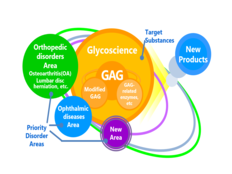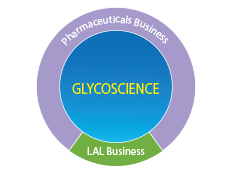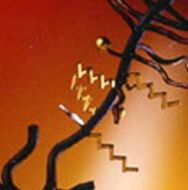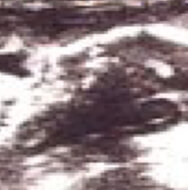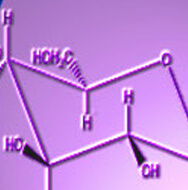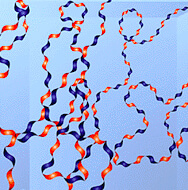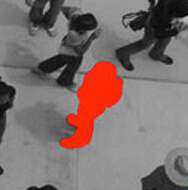In contrast to normal cells, cancer cells proliferate abnormally.When cells become cancerous, how do they differ from normal cells?
The point at which cells stop proliferating is called contact inhibition. However, contact inhibition does not occur in cancer cells, i.e., cancer cells undergo unregulated proliferation. Further, as a rule, cells that constitute multicellular organisms eventually die, but cancer cells continue to proliferate and often have a different morphology from normal cells. This is one of the distinctive characteristics of cancer cells.
In addition to such differences that can be observed with a microscope, there are many other differences found at the sub microscopic level. Among these is the difference in sugar chains on the cell surface.
The concept that sugar chains on the cell surface change when cells become cancerous was reported in the late 1960s. In actuality, normal cells and cancer cells express the same kinds of sugar chains. It has been discovered, however, that in highly metastatic cancer cells, after malignant transformation has fully advanced, the amount of giant sugar chains that is only sparsely expressed in normal cells increase. Part 1: "Sugar chains glimpsed in every corner of the life phenomenon" notes that "the sugar chain is the face of the cell", and based on those words, it can be said that cancer cells are transfiguring their "faces."
Substances that can be markers for cancer cells are generally called tumor markers, and the development of a monoclonal antibody each specifically recognizes each marker will enable its use as a diagnostic drug for cancer.
There are many diagnostic drugs in practical use that originate from sugar chain antigens. Active development of monoclonal antibodies against sugar chains that will be markers of cancer cells is currently under way, and it is expected that in the future, more and more diagnostic drugs will be ready for use in medical institutions.
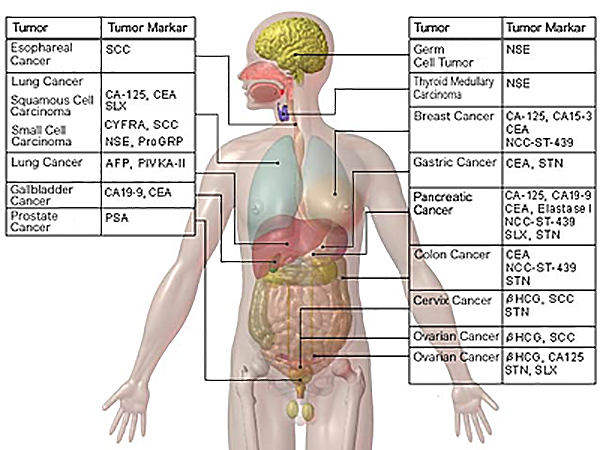
▲ A Table Showing Tumor Markers
Reprint from National Cancer Center website: provided by META Corporation Japan
It has been shown that sugar chains change when one has cancer. What does that mean?
From the cancer cells' point of view, such changes facilitate control of the immune functions of the host and therefore survival, as well as metastasis to other tissues.
Controlling immune functions can be considered in relation to a widely known phenomenon of cancer cells releasing their own antigen to the outside of the cell. For example, when normal spleenocytes of mouse are cultivated with antigens released by a particular kind of cancer cell, significant decrease in the activity of a particular kind of lymphocyte is observed. It is believed that possibly by way of such a mechanism, cancer cells avoid the "surveillance" of the host's immune system so they can proliferate and metastasize. In melanoma cells, however, it is known that when large amount of a sugar chain called sialyl Lewis X is present on the cell surface, the cell is more likely to undergo attack by immune cells called NK cells. This phenomenon shows that the immune system senses the sugar chains of cancer cells.
In light of such findings, several clinical trials of cancer vaccines based on sugar chains are currently under way. In addition, a recently published paper reports that in a mouse with destroyed genes of N-acetylglucosaminyltransferase (GnT-V), a kind of a glycosyltransferase , metastasis of cancer is suppressed, and that in a highly metastatic cancer the activity of GnT-V is increased.
Elucidation of the detailed mechanism of the GnT-V to facilitate metastasis of cancer is just beginning .There is a possibility that metastasis developes by canser cells adhering to target tissue cells via a cancer sugar chain antigen. Lymphocytes are drown to a particular tissue once such an antigen is present . The role of sugar chains in cancer metastasis and cell adhesion as well as in more universal life phenomena may be clarified by advances in future research.
♦Glycoforum
In "GlycoWord", a subcategory of "Glycoforum", key words of research in glycoscience are classified into genres, and a specialized researcher in that field has written a commentary.
About Cancer and Sugar Chains
♦National Cancer Center
This institute is the core of cancer control in Japan. Substances that can act as markers for cancer cells are introduced in a clear and simple manner in the tumor marker page.



